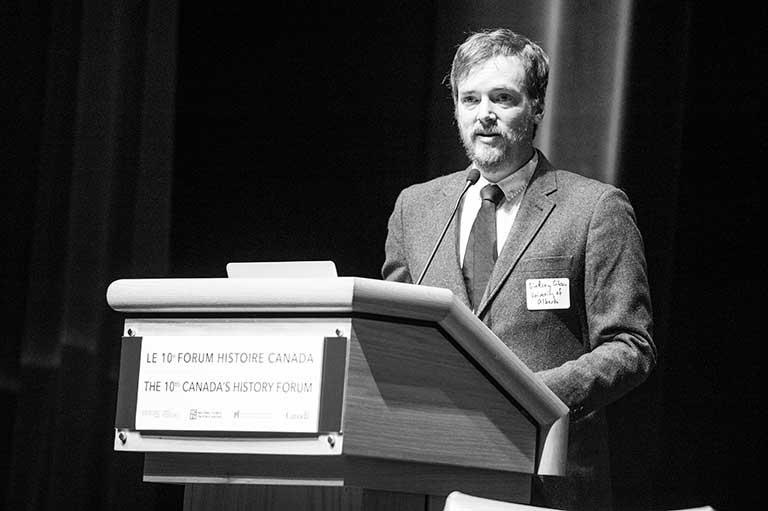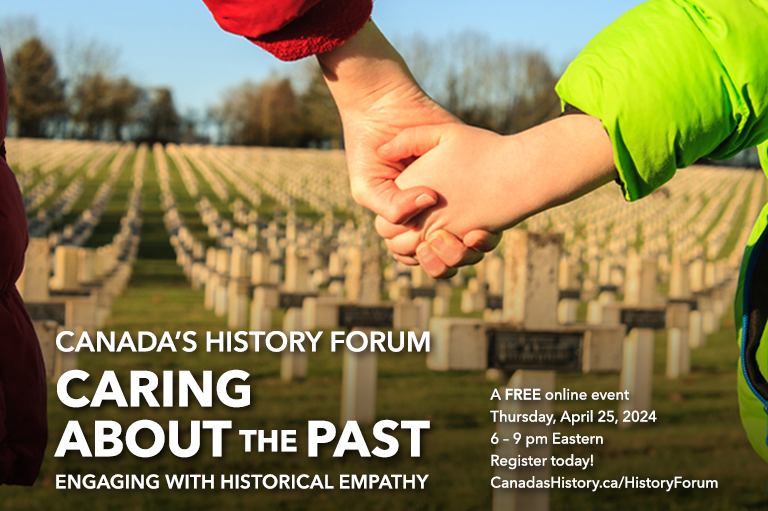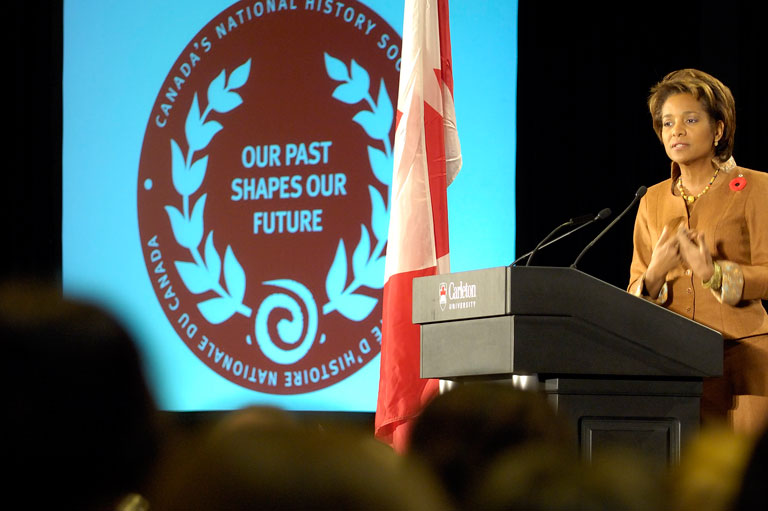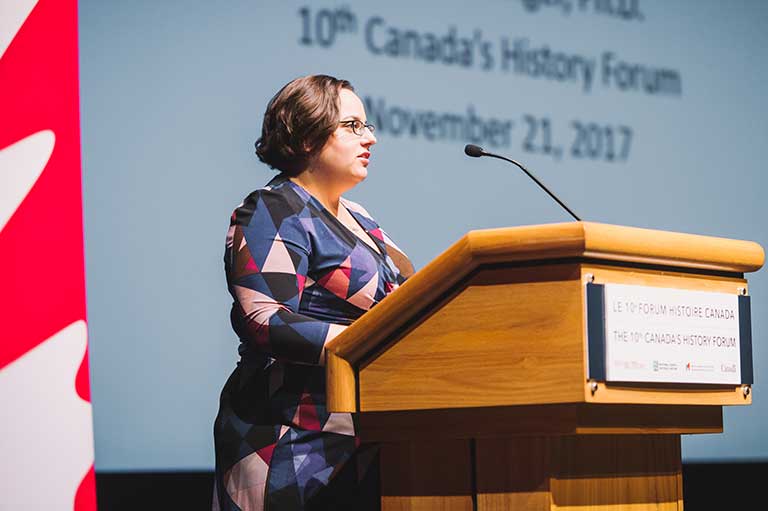Where Have We Been and Where Do We Go From Here?
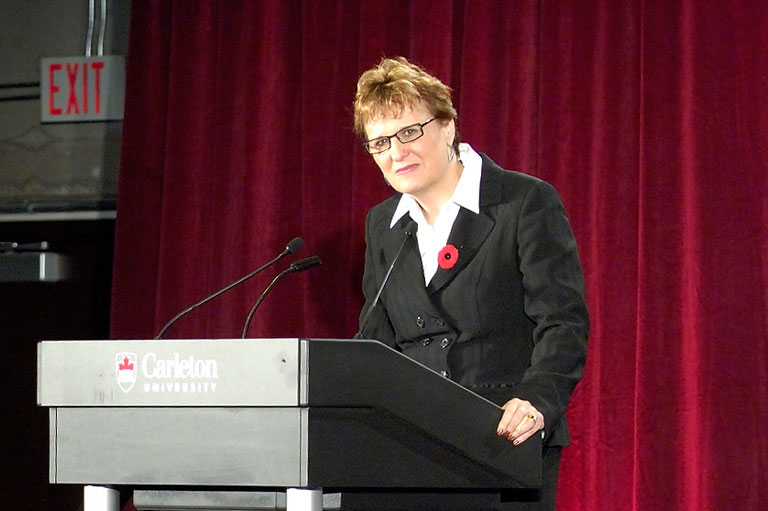
This presentation was given at the first Canada’s History Forum held on November 2, 2007 at Carleton University. The forum was held in conjunction with the 2007 Governor General’s Awards for Excellence in Teaching Canadian History.
The questions posed for this forum are important ones. While they are not new, they are persistent; having prevailed since the inception of history as a school subject in this country.
Recently, I viewed the film, History Boys, in which eight high-achieving 17 and 18 year old male students in Sheffield, United Kingdom, are preparing for entrance exams to Oxford or Cambridge and three teachers with quite different perspectives are preparing them for these exams. Hector, their General Studies teacher, quoting poet A.E. Houseman, tells the boys that “All knowledge is precious whether or not it serves the slightest human use.” He teaches them about poetry, drama and music, wanting them to be well rounded and cultured. Mrs. Lintott focuses on crucial names, dates, and events, exhorting them with, “You don’t just need to know it. You must know it backwards, boys. Facts, facts, facts!” The young substitute teacher, Irwin, is hired for the express purpose of preparing the boys for the exam, because the headmaster does not think the other teachers are quite up to the mark. Irwin takes a different tack. Abandoning concepts of evidentiary support for historical interpretations, Irwin encourages the students to offer contrary interpretations with or without evidence, so that their essays will offer fresh perspectives, and thus stand out from the herd. He says: “What has [truth] got to do with it? What has [truth] got to do with anything? . . . Truth is no more at issue in an examination than thirst at a wine-tasting or fashion at a striptease.” He encourages them to “poach” pieces of the poems, stories, and philosophical treatises which they have learned in Hector’s class to use as “gobbets” [his term] of information in the service of making their essays appear more erudite, a utilitarian approach with which Hector takes issue. The film explores the nature and purposes of teaching and learning history, what is meant by “truth” in history, and how these questions play out in the context of highstakes testing. We need to ask these questions because school history is important. Although students are exposed to history in many settings, it is only in school that they have opportunities to experience it in systematic ways that involve breadth and depth.
Since my presentation comes first, it seems fitting to provide some historical context to the debates from which the questions set out for this forum have emerged. These questions have been answered in different ways over time. I will describe four approaches to history education which have been promoted in this country. I will sketch the turning points in history education over the past decade and suggest some possibilities for change, in the hope that they will generate further discussion. The first approach to history education is the Nationbuilding or Grand Narrative approach. Its purpose is to build a sense of identity by presenting students with a chronological framework of important events around a theme of overcoming adversity and making progress towards nationhood. This may be accompanied by stories about people and events intended to foster a sense of pride in Canada’s accomplishments in spite of adversity. This approach is characterized by textbook titles such as Challenge & Survival or Bold Ventures. The first aspect of this approach is represented by Mrs. Lintott, in History Boys, who emphasized the important facts. The second aspect, what Jerome Bruner refers to as “the shadowy epistemology of the story,” is represented by Irwin, the substitute teacher.
A second approach, which came into prominence in the 1960s, we will call the Discipline-based approach. It was characterized by presenting students with primary sources and having them work with those sources as historians would work; comparing different kinds of evidence, considering the perspectives of the creators of the evidence, and developing narratives. This approach was more apparent in the curriculum rhetoric than in classroom reality. I saw no evidence of it in History Boys. The third approach, popular in the 1970s and ‘80s, is the Contemporary Problems approach. The view here was that history was only important to the extent that it could inform students’ understanding of, and ability to deal with, problems of contemporary concern. It is exemplified in the 1981 Alberta social studies curriculum, which took as its definition of social studies the following: “Social studies is the school subject in which students resolve issues of public and personal concern” – period. The fourth approach is Historical Thinking, which explicates second-order or procedural concepts such as perspective-taking, use of evidence, agency and significance, which undergird the substantive historical concepts concerning when things happened, where and why. Ken Osborne, Professor Emeritus, University of Manitoba Faculty of Education, has clearly laid out purposes for teaching history. He said that history education should: stimulate interest in the past, a sense of connectedness with what happened before we were born, and an appreciation of the present in the context of the past and the future; introduce us to the nature of history as a form of disciplined inquiry; illustrate the range of human behaviour; portray human beings as active agents in the historical process; and help us understand the nature of the country of which we are citizens and the world of which it is a part.
Now, I will step back to January, 1999. It was at this time that the “Giving the Past a Future” Conference, jointly sponsored by the McGill Institute for the Study of Canada and the Association for Canadian Studies, took place. It was billed as the “largest Canadian conference ever on the teaching and learning of history,” and, with a reputed 750 people in attendance, no doubt was. It was a turning point in history education in this country.
The conference took place at a time of despair, both about the precarious place of history in the curriculum and the quality of history teaching in schools. I will point to three indications of this. The Fall 1996 issue of Canadian Social Studies was a theme issue, which took on the task of exploring “Perpetual Questions and Persistent Issues in Canadian Social Studies,” and included articles by contributors from nine provinces and the Yukon. Editors, Alan Sears, Gerry Clarke and Andrew Hughes of the University of New Brunswick, pointed out, in a marked understatement, that there was “an undercurrent of concern running through many of the articles.” To give one example, in his article, Ken Osborne expressed despair that in the climate of school reform in the province of Manitoba, “science and technology hold the spotlight, together with a narrow definition of literacy, while social studies, history, geography, and the arts and humanities in general, are ignored or downgraded” (p. 28). Osborne concluded by stating, “the downgrading of history . . . is neither an aberration nor an accident. It is part of a wider move to sweep the very idea of democratic citizenship aside” (p. 30). Two years later, Jack Granatstein published his best selling polemic, Who Killed Canadian History? in which he blamed the demise of school history on various factors, including: the narrow research focus of many historians; the interdisciplinary nature of the school subject of social studies; decreased time allotments for history teaching; an overemphasis on teaching skills, rather than content; and the success of determined interest groups in getting their particular agendas into the curriculum, hindering the development of a national story. The specter of four surveys of Canadian history knowledge, conducted on behalf of the Dominion Institute, on which Canadian young people performed dismally, also haunted the conference.
The “Giving the Past a Future” conference was highly charged and controversial. For example, I recall that a number of people stood up at various times and proudly proclaimed themselves to be killers of Canadian history due to their interest in bringing to the fore the experiences of marginalized groups. Historian Veronica Strong-Boag, for one, declared that, “the past has always been contested space because we have never had a single history.” Rudyard Griffiths of the Dominion Institute arrived at the conference prepared to discuss national standards, but some members of the audience were not so inclined. There were lively debates. As historian Desmond Morton remarked, “No-one [will] confuse this conference with a funeral.”
No, not a funeral. With apologies to Mark Twain, “the reports of . . . [the] death [of history] were greatly exaggerated.” The conference signaled a turning of the tide in history education. Its participants represented a diverse array of perspectives. There were historians, history educators from Faculties of Education, provincial Department of Education curriculum developers, and public historians, including museum educators, and representatives from a range of organizations devoted to the teaching of Canadian history, both inside and outside of schools. This was important because for many years there had been little communication among these various stakeholders in history education. However, there was one group missing. I wrote a column called “Current Concerns” for Canadian Social Studies at the time and afterwards, I asked in my column, “Where were the teachers?” At least for me, their absence was notable.
Nevertheless, the conference was a catalyst for change in classrooms. It was at there that Lynton R. (Red) Wilson, who was then Chairman of the Board of Bell Canada, announced his intention to donate $500,000 dollars from his personal funds for the establishment of a foundation to promote the effective teaching of Canadian history in schools. This was the beginning of Historica, which sponsored teacher summer institutes for secondary teachers for a number of years, produced the Historica Minutes, and lesson plans to accompany them, and continues to sponsor Heritage Fairs for elementary students. This leads me to a second turning point; namely the vast array of resources that are now available to teachers. First, there are now a number of organizations that are filling what was a void. There is Canada’s National History Society, which publishes Beaver and Kayak, and which has sponsored this forum. There is the Association of Canadian Studies, which offers biennial conferences on the teaching of history, often in conjunction with provincial teachers’ associations. There is the Dominion Institute with its immigrant and veteran speakers’ bureaus, essay contests, conferences, and essay and short story collections. Second, there is the vast array of digital resources now available. The McCord Museum in Montreal stands out as an exemplar of approaches that public history sites can take to the organization of their digital resources for teaching purposes.
A third turning point is the burgeoning of scholarly research about the teaching and learning of history. In fact, the catalyst for this change had already occurred at the time of the Montreal conference, but few of us had noticed. This was Peter Seixas’s 1996 article, “Conceptualizing Growth in Historical Understanding,” published in The Handbook of Education and Human Development. Seixas articulated a framework for the field of history education involving the second-order concepts mentioned earlier. Seixas was acknowledged for his groundbreaking work with a Canada Research Chair in 2001; which led to the establishment of the Centre for the Study of Historical Consciousness in the Faculty of Education at the University of British Columbia. This conceptual organization has encouraged those of us who work in the field, to frame our research in new ways. It also has enormous implications for curriculum development and textbook design, although it has not yet been extensively taken up at these levels. An exception is Teaching About Historical Thinking, a collection of teaching strategies related to these concepts, published by the Critical Thinking Consortium.
What I have presented so far could be called a macropicture of the state of history education in Canada over the past decade. But, what about the micro-picture, the classroom? These turning points are only significant if they have an impact on what goes on in classrooms. For one thing, we can expand our resources to include those we have not considered before. For example, literature is a powerful way to provoke an emotional response in students because they feel a part of the scenes described. They care about the characters. Students relate to people in narratives in ways that they do not when they read about people and events in textbook accounts. I ask my students: When was the last time you cried over a textbook? Probably everyone in this room is aware of the rich body of historical literature on Canada that is now available. For younger students, there are the Dear Canada and Our Canadian Girl series, And, of course, senior secondary students have access to the array of literature available to adults.
And, we have the CBC/Radio Canada series, Canada: A People’s History, which has contributed to fill a void in filmic materials. I also note the proliferation of new biographies. Penguin, for example, is preparing biographies on Emily Carr, Lord Beaverbrook, Nellie McClung and Big Bear, as well as a number of others which will be published over the next two years.
Graphic novels are another resource we often do not consider for their value in history classrooms. They have an innate appeal, perhaps stemming from both their comic book heritage and their affinity to hypertext, that, for many students, is not present in accounts that rely solely on written text. Chester Brown’s Louis Riel: A Comic Strip Biography is one example of a graphic novel that could have a place in history classrooms. Brown steps back from his narrative, providing at the book’s conclusion, a commentary about his decisions related to use of the historical evidence. At one point, he observes, “The way I’ve drawn this scene makes the conversation seem more casual than it probably was” (2003, p. 246). At another point, he provides two different versions, with their sources, of the words spoken to Riel by the hangman at his execution (p. 267). His commentary raises compelling epistemological issues which provide a glimpse into the questions that historians ask of their sources and the ways they draw inferences. This is a powerful way to make students aware that history is merely the way we select from and choose to interpret the vast array of possibilities presented by the past.
These resources should be used in ways that go beyond mere celebration and promotion of identity. This involves helping students see that there is a difference between the past and history. In fact, what we call history is a deliberate selection and interpretation of the past. Historian Christopher Moore once remarked that, “history is less the story of the past than an argument about the past.” We can encourage students to enter into that argument by helping them to ask questions such as: Who created this account? For what reasons? Who was the intended audience? What kinds of historical evidence are used? Is one account more credible than the other? Why? Whose perspectives on this event are absent? We can also provide opportunities for students to shape their own arguments by using primary sources to create their own accounts. I want to make the point that historical knowledge does have a significant role in this, and not merely as fodder for teaching students about the nature of history as a discipline. Students require knowledge in order to situate themselves historically, to better understand where they have come from and to consider where they are going.
But resources on their own are inert. They need a teacher who can use them to effectively teach historical thinking. This is where we need to direct attention to three areas. The first is pre-service teacher education; that we ensure that history teachers have adequate preparation before they begin teaching. The second is school district hiring practices. School district administrators must recognize the need for a high standard of history education, and choose to hire teachers with strong history backgrounds – and only then ask if they can coach soccer.
Finally, we need an intellectual space where people representing the various constituencies involved in history education can communicate with one another. There is a gap between history teachers and historians, with teachers often viewing the work of historians as academic, meaning pretentious and irrelevant, and academics viewing the work of teachers as either ineffective, or what Ruth Sandwell has called “a more or less benign form of government propaganda.” Believe it or not, at one time it was not at all uncommon for historians and history teachers to collaborate on textbooks. The 1948 text, Canada: A Nation and How it Came to Be by historian A.R.M. Lower and high school teacher J.W. Chafe, is one example.
This brings me to THEN/Hier (The History Educators’ Network/ Histoire et Éducation en Réseau), which has a mandate to promote dialogue among history education stakeholders. Ruth, Jocelyn and I are in the process of applying for a Social Sciences and Humanities Clusters grant to support and expand the work of this fledging organization. Currently, we have 16 Canadian and two international partners, including Canada’s National History Society, the Great Unsolved Mysteries Project, the Simulating History research project, and the Centre for Media and Culture in Education. We are currently contacting every social studies and history teachers’ association in the country to see if they are interested in becoming involved. We intend to sponsor annual symposia, develop curriculum materials, promote graduate student exchanges and publish an e-journal. Our ultimate goal is to produce a policy recommendation document, which would provide models of research-informed best practice that we will present to the Council for Ministers of Education and other groups. Our hope is that this will mark another turning point in history education in this country. We are up to the challenges ahead of us, but it will take a concerted effort on the part of all of the groups involved in history education, not just the classroom teachers who work with it day by day.
We have to stop and listen to one another’s concerns, but we also must acknowledge one another’s triumphs. And therefore, I would like to salute the winners of the Governor-General awards and the other teachers who are here today, for your ongoing efforts to make students realize that history matters.
References
Brown, Chester. Louis Riel: A Comic-Strip Biography. Montreal, QC: Drawn and Quarterly Publications, 1999.
Conrad, Margaret. “Public History and its Discontents or History in the Age of Wikipedia. Journal of the Canadian Historical Association, in press.
Granatstein, J.L. Who Killed Canadian History? Toronto: HarperCollins, 1999.
Hicks, David & S. Van Hover. “Just One Fucking Thing After Another”: Exploring the Nature and Purpose of History and Education Through The History Boys. Theory and Research in Social Education (Summer 2007): 492-500.
Hytner, N. The History Boys [Motion Picture]. Fox Searchlight Pictures, 2006.
Osborne, Ken. “To the Past”: Why We Need to Teach and Study History. In Ruth Sandwell, ed. To the Past: History Education, Public Memory and Citizenship in Canada (pp. 103-131). Toronto: University of Toronto Press, 2006.
Sandwell, Ruth. “Introduction: History Education, Public Memory, and Citizenship in Canada.” In Ruth Sandwell, ed. To the Past: History Education, Public Memory and Citizenship in Canada (pp. 3-10). Toronto: University of Toronto Press, 2006.
Seixas, Peter. “Conceptualizing the Growth of Historical Understanding.” In Handbook of Education and Human Development: New Models of Learning, Teaching, and Schooling, ed. David Olson and Nancy Torrance. Cambridge, MA: Blackwell, 1996.
Themes associated with this article
Advertisement

